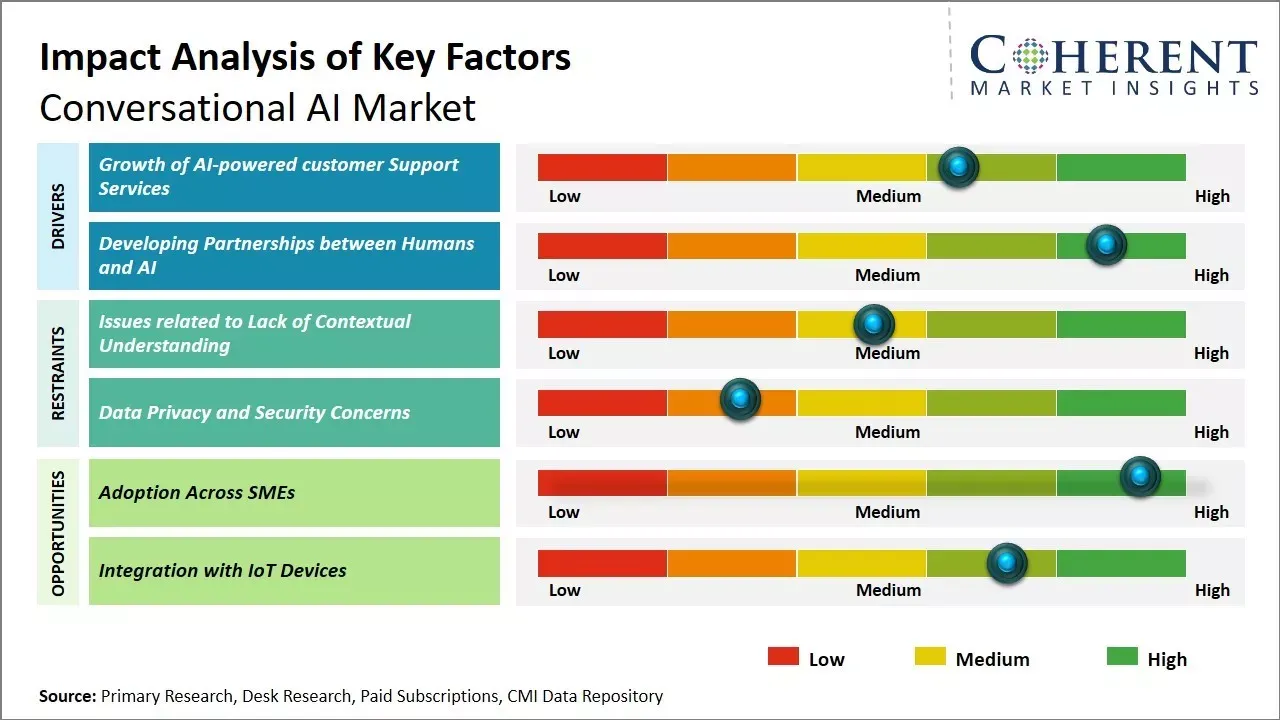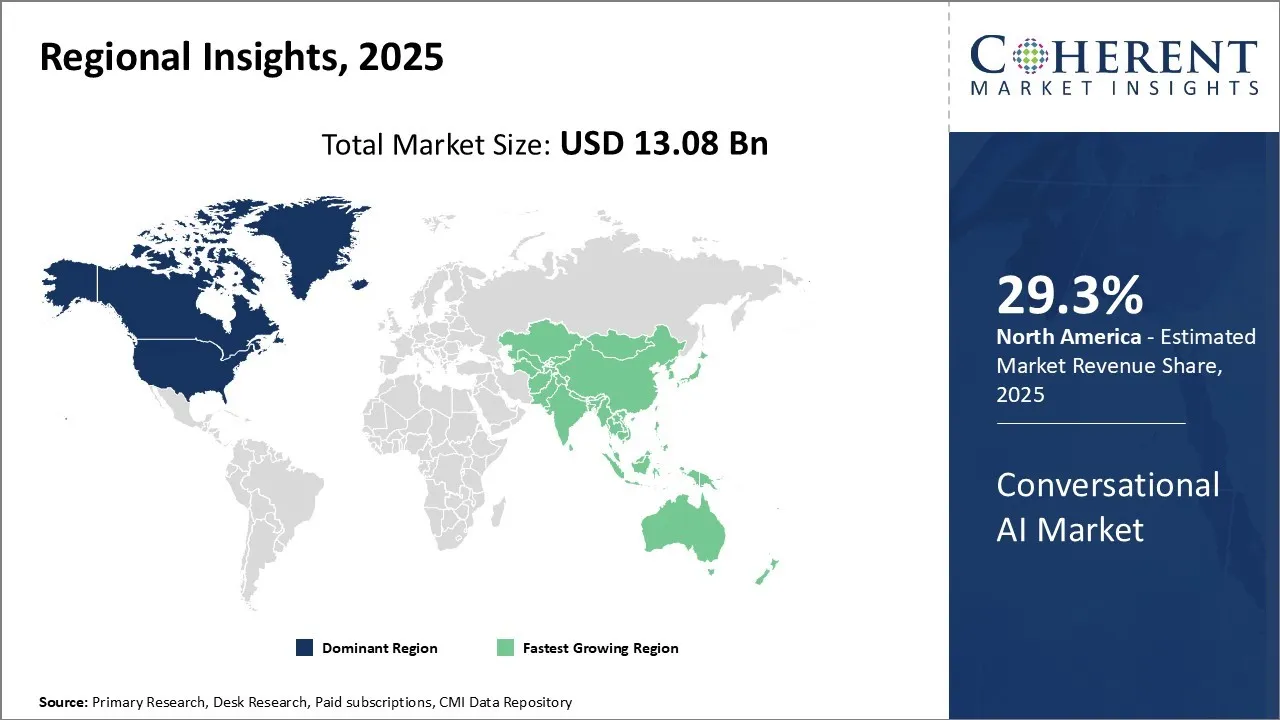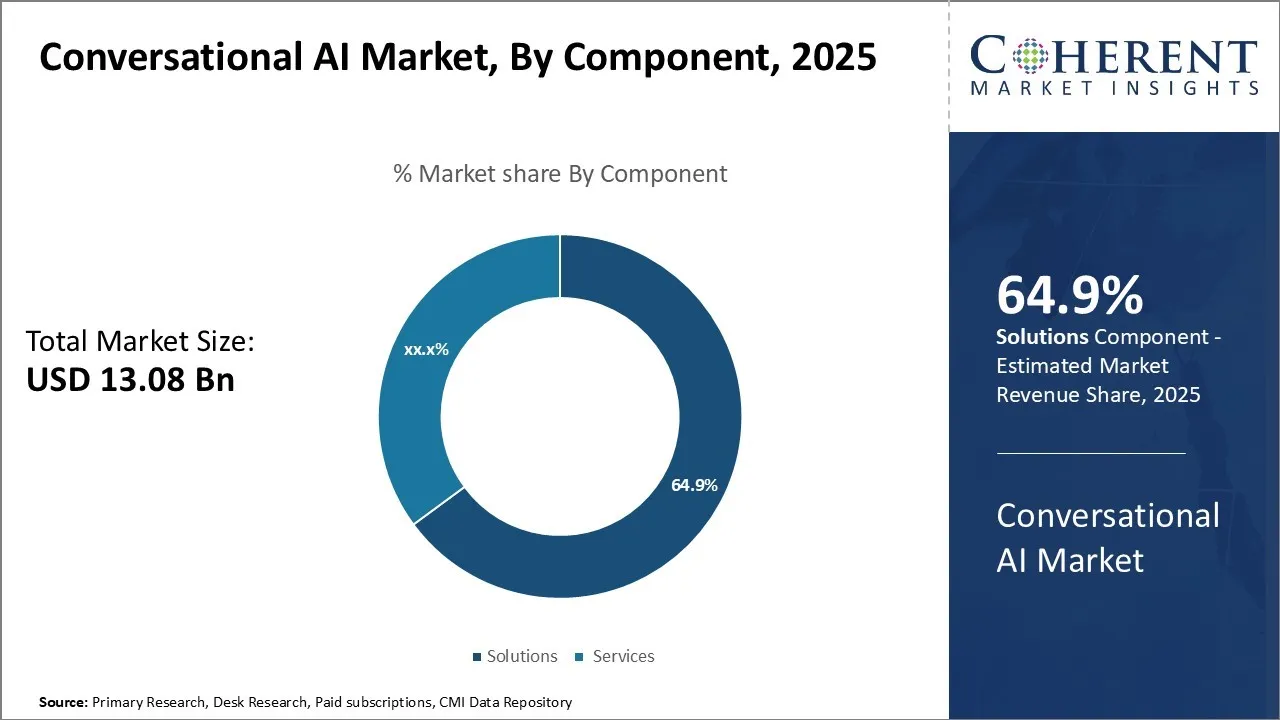Conversational AI Market Size and Trends 2025 - 2032
The conversational AI market is estimated to be valued at USD 13.08 Bn in 2025 and is expected to reach USD 55.11 Bn by 2032, growing at a compound annual growth rate (CAGR) of 22.8% from 2025 to 2032.

To learn more about this report, Download Free Sample
Key Takeaways
- Based on Region, North America is dominating the market, accounting for around 29.3% in 2025, owing to a strong technological hub.
- Based on End-user, the E-commerce segment is leading with 23.8%, owing to continuous innovations.
- Based on the Type, the Chatbots segment is dominating with 67.7%, driven by increasing popularity of messaging platforms.
- Based on Component, the Solutions segment is leading with 64.9% in 2025, owing to an increase in demand for automation.
Market Overview
The widespread adoption of conversational platforms across industries, such as retail, BFSI, healthcare, travel, and hospitality, is expected to drive significant growth in the market during the forecast period. The conversational AI market is expected to witness strong growth over the coming years. Increased investment in AI and natural language technologies by major technology companies is supporting the development of more human-like conversational interfaces. Additionally, the need for automation and personalized customer engagement is promoting the adoption of conversational AI solutions in applications such as web virtual assistants, chatbots, and voice assistants.
Current Events and Its Impact
|
Current Events |
Description and its impact |
|
Consumer Platform Evolution |
|
|
Generative AI Infrastructure Investments |
|
Uncover macros and micros vetted on 75+ parameters: Get instant access to report
Data Privacy Concerns in Conversational AI
Conversational AI systems process vast amounts of sensitive user data, including personal details, conversations, and behavioral patterns, raising significant privacy issues. Users worry about how their data is collected, stored, and used, especially given the risk of unauthorized access or data breaches. For example, the Cybernews Business Digital Index reports that almost 90% of the AI tools examined have experienced data breaches, posing significant risks to businesses.
There is concern over insufficient transparency regarding data handling practices and whether conversations are recorded or analyzed beyond the intended purpose. Compliance with regulations like GDPR and CCPA remains a challenge for many providers. Ensuring strong encryption, secure data storage, and clear privacy policies is essential to maintain user trust and protect sensitive information. For instance, in January 2025, DeepSeek, the Chinese AI company experienced a major data breach, over a million lines of sensitive inormation, including chatlogs and software keys.
Conversational AI Market Insights, by Component - Growing Adoption of Automation Drives the Solutions Segment
The solutions segment is estimated to contribute the highest share of 64.9% in 2025 in the market owing to increasing demand for automation across industries. Conversational AI solutions provide an automated way for organizations to engage with customers, enabling round-the-clock support without needing additional human resources. The use of dialog systems and natural language interfaces has seen rapid growth as it allows businesses to scale customer support operations efficiently.
In the banking sector, chatbots are widely deployed to answer basic customer queries and direct them to the appropriate human agents for complex issues. This frees up employees to focus on more complex tasks. Automated assistance is also gaining popularity in e-commerce to handle high volumes of repetitive questions from online shoppers. Solutions allow personalizing customer experiences based on their interactions and purchasing history.
Moreover, conversational interfaces add a human-like element to IoT devices, bringing intelligence to home appliances, smart speakers, and virtual assistants. As voice control gains ground, solutions providers are enhancing capabilities around voice recognition, contextual understanding, and multilingual support. Institutions are attracted to the cost savings and round-the-clock availability that automated platforms offer compared to traditional call centers. The rise of virtual assistants on mobile apps further propels the solutions segment. For instance, in February 2022, IBM introduced IBM watsonx Assistant, a market-leading, conversational artificial intelligence platform.
Conversational AI Market Insights, by Type - Growth of Messaging Platforms Drives the Chatbots Segment
The chatbots segment is estimated to contribute the highest share of 67.7% in 2025 in the market driven by increasing popularity of messaging platforms. Chatbots have emerged as the most widely adopted form of conversational AI due to their seamless integration with messaging apps. Customers have grown accustomed to chatting with brands through Facebook Messenger, WhatsApp, Wechat, and other platforms.
Businesses are eager to deploy chatbots on these channels to stay connected with customers in a convenient, personalized manner. Chatbots allow customers to find information instantly through natural dialogue rather than browsing menus or websites. They are well-suited for handling high volumes of basic inquiries from customers. This keeps human agents free for more complex queries that require judgment and problem-solving skills.
As messaging becomes the preferred mode of communication globally, chatbots are poised to take on more human-like qualities through advances in NLP. They can understand context, exhibit memory, and maintain conversations over long periods to deliver engaging customer experiences. Chatbots are also being incorporated into customer support workflows on company websites and mobile apps. This creates a unified experience for customers across different touchpoints. Starting June 2, 2025, the Telangana government introduced slot booking and an AI chatbot for property registrations, expanding the pilot from 47 to all 144 sub-registrar offices statewide.
Conversational AI Market Insights, by End-use Industry - Continuous Innovation in Retail Drives the e-Commerce Industry
The retail & e-commerce segment is estimated to contribute the highest share of 23.8% in 2025 in the market owing to continuous innovations in the retail sector. The explosive growth of e-commerce has increased demand for conversational assistance that can guide customers through their shopping journey. Interactive shopping experiences are being designed to feel more natural than static websites.
Chatbots help customers browse products, get recommendations, track orders, and manage accounts using natural language. For instance, according to a report published in March 2025, around 60% of the consumers in the United States use conversational AI tools like ChatGPT or Gemini for shopping. They use AI particularly for saving time and offering personalized recommendations. They are highly effective at reducing cart abandonment rates by answering questions and resolving issues in real-time. For instance, fashion retailers deploy virtual stylists to suggest outfits and sizes based on customers' preferences. Grocery stores use chatbots that can read shopping lists and direct customers to product aisles.
As mobile commerce expands, retailers implement conversational interfaces into mobile apps and messages to stay within a click of their customers. Moreover, voice assistants integrated with e-commerce platforms allow shopping through commands. This elevates convenience for customers and increases cart values. Lastly, data gathered from conversations helps merchants gain real-time insights into trends, demand patterns and personalize offers.
Regional Insights

To learn more about this report, Download Free Sample
North America Cnversational AI Market Trends
North America has firmly established itself as the dominant regional market for conversational AI currently. It is estimated to contribute the highest share of 29.3% in 2025 in the market. With technological hubs like Silicon Valley located here, this region is home to the largest tech companies globally who are pioneering research and development in this field. Companies, such as Amazon, Microsoft, Apple, IBM, and Google, have invested heavily in building their own conversational AI platforms as well as making key acquisitions of startups working in this area. For instance, in May 2025, Conversational AI 2.0 was launched by ElevenLabs. The new version is all set to introduce advanced turn-taking capabilities, thus, enabling agents to manage interruptions and allow the conversation to flow naturally.
The presence of such industry giants has created a huge demand for conversational AI solutions from enterprises across various sectors looking to integrate these technologies into their products and services. Coupled with high technological adoption rates, North America accounts for the largest share of the overall conversational AI market spend today. Furthermore, cutting-edge research in AI happening at top universities also feeds into continued innovation in conversational technologies, thereby strengthening the region's leadership position.
Asia Pacific Conversational AI Market Trends
The Asia Pacific region is seeing the fastest growth in the conversational AI market currently. Several factors are driving this growth. The ever-increasing penetration of internet and smart devices is opening up massive opportunities for the deployment of conversational interfaces. Countries like China and India especially are digitalizing rapidly and have the highest number of internet users globally. This makes Asia Pacific an attractive market for scaling conversational solutions.
Additionally, various national 'Digital India' and 'Made in China 2025' initiatives are promoting local entrepreneurship and new technologies strongly. This has fostered the emergence of startups developing conversational AI products tailored for the local population's needs. The presence of booming technology hubs like China's Shenzhen and India's Bengaluru further stimulates innovation and commercialization capabilities. Local tech giants such as Baidu, Alibaba, Tencent, and Flipkart along with R&D centers of multinationals are also doing significant work to advance conversational AI. For instance, in February 2025, in India NoBroker introduced its ConvoZen.AI, it is an end-to-end conversational AI cloud platform. It is specifically designed to automate and monitor interactions.
The combination of above factors is translating to Asia Pacific becoming a hub for rapidly growing conversational AI deployments across a variety of fields including banking, e-commerce, healthcare, and others. While North America still holds the leadership position, the Asia Pacific region is positioning itself as the new global frontier for this revolutionary technology.
United States Conversational AI Market Trends
The conversational AI market in the United States is expanding quickly due to growing demand for automated and efficient customer interactions. Improvements in machine learning and natural language processing technologies have enhanced the ability of AI systems to understand and respond like humans. Companies are increasingly deploying chatbots and virtual assistants across various platforms including websites, mobile devices, and social media to improve service delivery. Sectors like healthcare, finance, and retail are major adopters, using conversational AI to streamline operations and boost customer satisfaction. In March 2025, Agora, Inc. launched its Conversational AI Engine, a real-time platform enabling developers to build interactive voice experiences with any AI model, featuring ultra-low latency and advanced voice processing for seamless engagement.
Key Developments
- In June 2025, Mystore in Haryana, India, launched Mystore Genie. It is an AI agent built on Google Cloud’s Agentic AI framework. It is designed to specifically enhance buyer experience.
- In May 2025, boost.ai partnered with London-based Ciklum to combine Ciklum’s engineering expertise with boost.ai’s platform, delivering scalable AI solutions for enterprise clients.
- In May 2025, SoundHound AI partnered with Allina Health to deploy “Alli,” a patient engagement AI agent powered by its Amelia conversational AI platform.
- In February 2025, Gupshup Datalabs launched a library of 15 customizable AI agents to help clients drive revenue, improve customer experience, and increase operational efficiency.
- In January 2024, OpenAI, the AI powerhouse behind ChatGPT, introduced an innovative feature called GPT Mentions, offering users a seamless way to integrate custom GPTs or bots into conversations. This beta-stage feature is set to redefine the landscape of conversational AI dynamics, enabling users to effortlessly tag and invoke specialized AI models during their interactions.
- In August 2023, Baidu, a China-based multinational technology company, launched its chatbot, Ernie Bot
- In February 2023, Google, a U.S.-based multinational technology company focusing on artificial intelligence, launched Bard, a generative artificial intelligence chatbot powered by LaMDA
- In January 2022, Visionstate Corp. announced the launch of its new ViCCi 2.0 customer service kiosk powered by conversational chatbot artificial intelligence (AI)
- In November 2021, Google launched Bot-in-a-Box, a conversational AI tool.
Market Report Scope
Conversational AI Market Report Coverage
| Report Coverage | Details | ||
|---|---|---|---|
| Base Year: | 2024 | Market Size in 2025: | USD 13.08 Bn |
| Historical Data for: | 2020 To 2024 | Forecast Period: | 2025 To 2032 |
| Forecast Period 2025 to 2032 CAGR: | 22.8% | 2032 Value Projection: | USD 55.11 Bn |
| Geographies covered: |
|
||
| Segments covered: |
|
||
| Companies covered: |
Google, Microsoft, Amazon Web Services, Inc., IBM, Oracle, Nuance Communications, Inc., FIS, SAP SE, Artificial Solutions, Kore.ai, Inc., Avaamo, Conversica, Inc., Jio Haptik Technologies Ltd., Rasa Technologies Inc., Solvvy, Pypestream Inc., Kasisto, Cognigy, MindMeld, and Creative Virtual |
||
| Growth Drivers: |
|
||
| Restraints & Challenges: |
|
||
Uncover macros and micros vetted on 75+ parameters: Get instant access to report
Conversation AI Market Trends
Growth of AI-powered Customer Support Services
The rise of AI-powered customer support services is significantly contributing to the growth of the conversational AI market. As customers increasingly expect fast, efficient, and personalized experiences, companies are looking at ways to scale their support operations beyond traditional call centers. This is driving a huge demand for AI chatbots and virtual assistants that can handle high volumes of repetitive query handling through natural language conversations 24/7.
Many large enterprises are investing in sophisticated AI solutions that not only answer questions but can also resolve issues by taking required actions. For example, chatbots being deployed by telecom and utility providers can check account balances, make bill payments, track order status, and even activate or deactivate connections upon user request. This is empowering customers with instant self-service options while reducing operational costs for companies. Furthermore, COVID-19 has accelerated the digital transformation of customer support as lockdowns compelled organizations to virtualize their engagements through digital channels.
Going forward, the conversational AI industry is expected to further innovate as AI capabilities keep enhancing. Chatbots and virtual agents will gain abilities to deeply understand context and intent behind queries. They will be equipped with vast knowledge bases covering diverse topics. Embodiments using mediums like augmented reality and voice assistants will provide richer engagement experiences. As AI systems analyze massive conversation data over time, their responses will become more and more human-like and consistent. According to Eurostat, the usage of internet and electronic means of communication for contacting public authorities and utilities had increased in the EU from 32% in 2014 to 41% in 2020. This showcases growing customer preference for digital and AI-powered engagement channels.
Developing Partnerships between Humans and AI
Rather than focusing solely on replacing human capabilities, many companies are exploring how AI tools can empower, extend, and enhance human abilities. By developing AI-assisted partnerships between people and technology, new applications and possibilities are emerging. For example, AI agents are being designed to handle initial customer queries, freeing up specialists to work on more complex issues. Within organizations, AI is augmenting knowledge workers through features like search, translation, and automated note-taking. By intelligently routing certain tasks to AI while retaining humans for others, work becomes more efficient and satisfying for all. As both companies and consumers recognize the value in these types of AI-enhanced, human-AI partnerships, it fuels ongoing investment in developing conversational technologies that are useful aids rather than replacements. This collaborative model points the way towards sustained growth for the conversational AI sector.
Market Opportunities: Adoption across SMEs
As virtual assistants become more helpful, harmless, and honest over time through continued machine learning, user adoption will likely expand across more use cases and demographic groups. Partnerships between major technology companies and smaller start-ups also aim to more rapidly advance the state of the art. Furthermore, as conversational AI platforms automate more tasks, they could meaningfully reduce costs for businesses and public sector organizations alike. This is further positively influencing the conversational AI market forecast.
Role of AI in the Conversational AI Market
Artificial intelligence has now become a great way to get things done easily and is easily available at one’s fingertips. It is also greatly contributing to driving the Conversational AI market. With the integration of artificial intelligence and manufacturing processes, there is a significant increase in production rates. Artificial Intelligence also helps machines understand and interpret human language, what people say or type. For example, chatbots like Alexa and Siri work on this principle. Conversational systems that operate on AI can learn from conversations; it helps the system collect data and use it for personalized recommendations. Voice assistants that use AI, actually use the speech to text and text to speech models to communicate effectively.
Analyst Viewpoint
- The conversational Al market is poised for strong growth over the next five years. Major drivers for the market's expansion include the rising demand for chatbots and virtual assistants across industries as companies seek to improve customer engagement and service. With more businesses automating basic conversations and transactions, the ability of Al systems to understand natural language and process requests will be paramount.
- Limitations in current natural language processing and the lack of contextual awareness remains a restraint in the conversational Al industry. For most existing solutions, conversations are still rudimentary without deeper comprehension. This prevents broader commercial use beyond narrow domains. Data privacy is another restraint as user data needs to be handled securely when training virtual agents.
- North America dominates the rapidly expanding conversational Al market with heavy R&D investment from technology giants. The Asia Pacific region see significant growth led by increasing investments from China, India, and others. Europe presents substantial opportunities as companies aim to utilize Al for growth. The travel, retail, and healthcare sectors in particular are primed for disruption by conversational systems that can field common queries and transactions for customers and patients.
Market Segmentation
- By Component
- Solutions
- Services
- Managed Services
- Professional Services
- Training & Consulting
- System Integration & Implementation
- Support & Maintenance
- By Type
- Chatbots
- Intelligent Virtual Assistant (IVA)
- By Deployment
- On-premises
- Cloud
- By Enterprise Size
- SMEs
- Large Enterprise
- By End-use Industry
- BFSI
- Healthcare
- IT & Telecom
- Retail & E-commerce
- Education
- Media & Entertainment
- Automotive
- Others
- By Region
- North America
- U.S.
- Canada
- Latin America
- Brazil
- Argentina
- Mexico
- Rest of Latin America
- Europe
- Germany
- U.K.
- Spain
- France
- Italy
- Russia
- Rest of Europe
- Asia Pacific
- China
- India
- Japan
- Australia
- South Korea
- ASEAN
- Rest of Asia Pacific
- Middle East
- GCC Countries
- Israel
- Rest of Middle East
- Africa
- South Africa
- North Africa
- Central Africa
- North America
- Key Players
- Microsoft
- Amazon Web Services, Inc.
- IBM
- Oracle
- Nuance Communications, Inc.
- FIS
- SAP SE
- Artificial Solutions
- Kore.ai, Inc.
- Avaamo
- Conversica, Inc.
- Jio Haptik Technologies Ltd.
- Rasa Technologies Inc.
- Solvvy
- Pypestream Inc.
- Kasisto
- Cognigy
- MindMeld
- Creative Virtual
Sources
Primary Research Interviews
- In-depth interviews with industry experts, CXOs, product managers, and developers in the Conversational AI domain
- Discussions with end-users from sectors such as BFSI, retail, healthcare, and e-commerce
- Feedback from AI integration consultants and customer engagement strategists
Databases
- Statista
- IMF Data
- World Bank Open Data
- UN Data
- Crunchbase (for company-level insights)
- PitchBook (investment and M&A activity in AI tech)
Magazines
- MIT Technology Review
- Wired
- Forbes Tech
- CIO Magazine
- Harvard Business Review
Journals
- Journal of Artificial Intelligence Research (JAIR)
- ACM Transactions on Interactive Intelligent Systems
- IEEE Transactions on Neural Networks and Learning Systems
- Journal of Machine Learning Research (JMLR)
Newspapers
- The Wall Street Journal (Tech Section)
- Financial Time
- The Economic Times (Technology)
- The New York Times (AI and Business section)
- Business Standard
Associations
- Artificial Intelligence and Machine Learning Society (AIMLS)
- International Association for Artificial Intelligence (IAAI)
- Partnership on AI
- IEEE Computational Intelligence Society
- Voicebot.ai (industry analysis, trends, and use cases)
Public Domain Sources
- Company websites and press releases
- SEC filings and investor presentations
- Government policy briefs and AI strategy documents
- Public webinars and whitepapers from tech providers
- Industry conference proceedings (e.g., CES, Web Summit, AI Expo)
*Definition: The conversational AI market involves the development and delivery of AI-powered chatbots, digital assistants, and other conversational platforms that can understand natural human language and automate interactions through messaging, voice, and other modalities. These conversational AI solutions are being adopted across various industry verticals to improve customer service, employee productivity, and data analytics through their ability to have human-like dialogue, perform on-device processing, and learn from interactions over time via machine learning technologies.
Share
Share
About Author
Ankur Rai is a Research Consultant with over 5 years of experience in handling consulting and syndicated reports across diverse sectors. He manages consulting and market research projects centered on go-to-market strategy, opportunity analysis, competitive landscape, and market size estimation and forecasting. He also advises clients on identifying and targeting absolute opportunities to penetrate untapped markets.
Missing comfort of reading report in your local language? Find your preferred language :
Transform your Strategy with Exclusive Trending Reports :
Frequently Asked Questions
EXISTING CLIENTELE
Joining thousands of companies around the world committed to making the Excellent Business Solutions.
View All Our Clients


